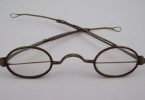Additional Experiment proving that the Leyden Bottle has no more Electrical Fire in it, when charg’d, than before; nor less when discharg’d. That in Discharging, the Fire does not issue from the Wire and Coating at the same Time, as some have thought; but that the Coating always receives what is discharg’d by the Wire, or an equal Quantity: the outer Surface being always in a negative State of Electricity, when the inner Surface is in a positive State.
Place a thick Plate of Glass under the rubbing Cushion, to cut off the Communication of Electrical Fire from the Floor to the Cushion: Then if there be no fine Points or hairy Threads Sticking out from the Cushion or from the Parts of the Machine opposite to the Cushion, of which you must be careful, you can get but a few Sparks from the Prime Conductor; which are all the Cushion will part with.
Hang a Vial then on the Prime Conductor, and it will not charge, tho’ you hold it by the Coating. But
Form a Communication by a Chain from the Coating to the Cushion, and the Phial will charge.
For the Globe then draws the Electrical Fire out of the Outside Surface of the Phial and forces it thro’ the Prime Conductor and Wire of the Phial into the inside Surface.
Thus the Bottle is charg’d with it’s own Fire, no other being to be had, while the Glass Plate is under the Cushion.
Hang two Cork Balls by Flaxen Threads to the Prime Conductor, then touch the Coating of the Bottle, and they will be electrified, and recede from each other.
For just as much Fire as you give the Coating, so much is discharg’d thro’ the Wire upon the Prime Conductor, whence the Cork Balls receive an Electrical Atmosphere. But
Take a Wire bent in this Form with a Wax Handle to hold it by, and apply one End of this Wire to the Coating and the other at the Same Time to the Prime Conductor; the Vial will be discharged. And if the Balls are not electrified before the Discharge, neither will they appear to be so after the Discharge, for they will not repel each other.
Now if the Fire, discharg’d from the inside Surface of the Bottle, thro’ its Wire, remain’d on the prime Conductor, the Balls would be electrified and recede from each other.
If the Vial really exploded at both Ends and discharged Fire from both Coating and Wire, the Balls would be more electrified and recede farther: for none of the Fire can escape, the Wax Handle preventing.
But if the Fire with which the inside Surface is surcharg’d be so much precisely as is wanted by the outside Surface, it will pass round thro’ the Wire fixt to the Wax Handle, restore the Equilibrium in the Glass and make no Alteration in the State of the Prime Conductor.
Accordingly we find that if the Prime Conductor be electrified, and the Cork Balls in a State of Repellancy, before the Bottle is discharg’d, they continue so afterwards: If not, they are not electrified by that Discharge.
To P. Collinson Esq. F.R.S. London

